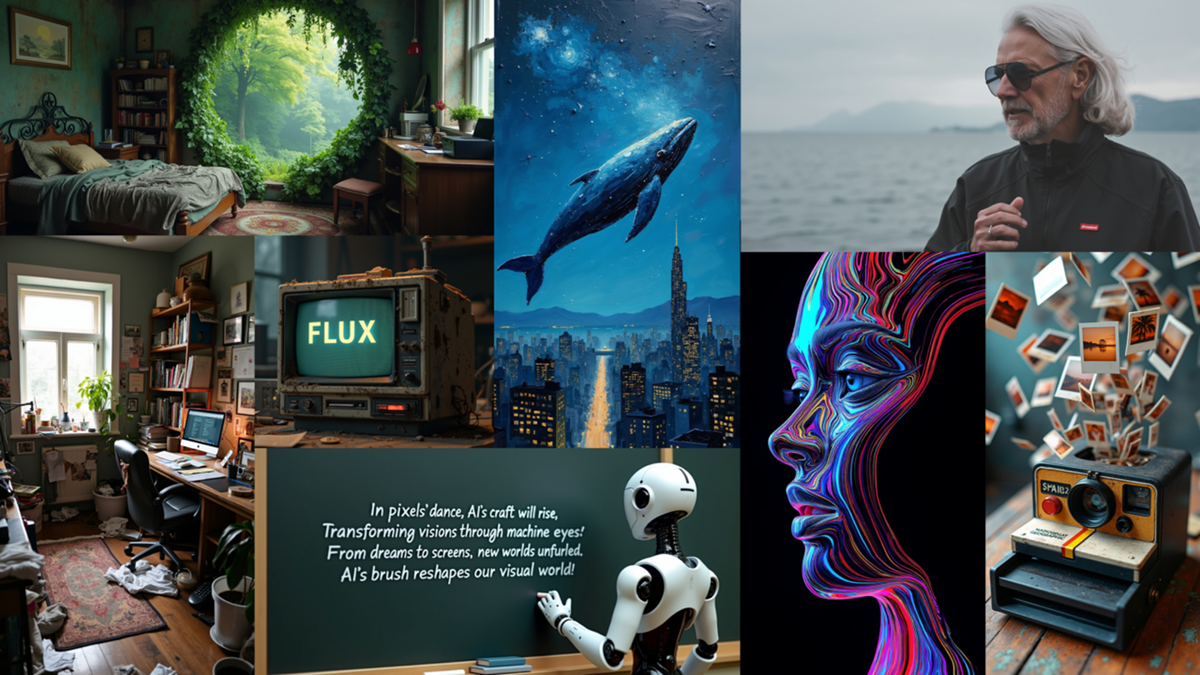
Viral Flux AI images look terrifyingly real
 ]
]
While AI art has proliferated over the past two years, the best AI image generators have remained largely the same. Adobe Firefly, Midjourney, DALL-E and Stable Diffusion have been fighting it out, which each one bringing new advances in each update.
But it seems Flux, a relatively new open-source AI-image generator, may be about to take the crown, at least when it comes to realism. Early experimenters running the model on their own devices have paired it XLabs’ Lora, a fine-tuning script that appears to add extra detail. The results are almost indistinguishable from photographs at a quick glance.
On closer inspection, the images can still be identified as AI-generated fairly easily. Text is the big giveaway, particularly small text on things like the lanyard and microphone in the image above. Patterns and textures can also look strange when you look at them, and elements can be out of proportion. That aside, at first glance, the images going viral on social media look like normal photos of normal people (I’m not sure who does a Ted Talk in a swimsuit, but that’s by the by).
What is Flux AI image generator?
Created by the startup Black Forest Labs, Flux AI image generator is being billed an heir to Stable Diffusion because it’s open-source. That means it’s code is freely available and anybody can tinker with it, modify the model and incorporate it into their own generators. Users can run Flux locally if they have a good enough computer, but it’s also available on multi-model platforms like Poe and Nightcafe.
There are actually three versions of Flux.01. There’s a Pro version available with a commercial licence, then there’s the mid-weight model Dev and a faster model Schnell (Black Forest Labs are based in Germany as you might expect).
While Ideogram impressed many when it burst onto to the scene a few month ago, Flux looks to now be the biggest competition for Midjourney in term of photorealism. The model itself appears to produce very realistic results, although skin textures can be less convincing and more plastic looking. But some users running have been getting terrifyingly realistic results when combining Flux with Lora, a fine-tuning script for photorealism made by XLabs.
The stunning realism of the images above have quickly turned them viral. They also have many people wondering what the benefits are, other than providing a bit of fun for machine learning hobbyists. The ability to create realistic images of non-real people could be a game changer for stock photography and advertising. There are already many smaller businesses and brands using AI images for social media pieces. But the risk of AI images being used to commit scams or create fake news is more terrifying than ever.
 ]
]
FLUX.1, a innovative AI image generator developed by Black Forest Labs, is set to make waves in the field of artificial intelligence. Created by a team of seasoned experts with extensive experience in AI image and video generation, including notable contributions to the renowned Stable Diffusion project, FLUX.1 offers a trio of distinct models tailored to cater to a wide range of user needs. As an open-source tool, it openly invites community-driven improvements and fine-tuning, fostering a collaborative environment that encourages continuous enhancement and innovation.
FLUX.1 AI Image Generator
The development team behind FLUX.1 brings to the table a wealth of expertise and knowledge in AI technologies. Their invaluable contributions to groundbreaking projects such as Stable Diffusion, VQ-GAN, and latent diffusion serve as a testament to their prowess, ensuring that FLUX.1 is built upon a robust foundation of advanced AI techniques. This solid groundwork positions FLUX.1 as a formidable contender in the realm of AI image generation.
Key Takeaways : FLUX.1 is an innovative AI image generation tool developed by Black Forest Labs.
The development team has extensive experience in AI technologies, contributing to projects like Stable Diffusion and VQ-GAN.
FLUX.1 offers three model variants: Schnell (fastest, for local development), Dev (balanced, for non-commercial use), and Pro (top-tier, for enterprise solutions).
Accessible on popular AI platforms like Hugging Face and Glyph, with free usage options.
Strengths include realism in generated images, high-quality text generation, and content flexibility.
Limitations include less effective illustration quality and weaker prompt adherence compared to DALL-E 3.
Future developments include expanding capabilities into text-to-video generation.
Open-source nature allows for community-driven improvements and continuous enhancement.
Comparison with other tools: FLUX.1 offers comparable realism to MidJourney, unique advantages over DALL-E 3, and more uncensored options than Stable Diffusion.
Potential for growth with the possibility of surpassing current leading tools in various aspects.
FLUX.1 is poised to become a leading tool in the AI image generation field due to its strengths and continuous innovation.
One of the standout features of FLUX.1 is its availability in three carefully crafted variants, each designed to cater to specific user requirements:
FLUX.1 Schnell : As the fastest model in the lineup, FLUX.1 Schnell is the ideal choice for local development and personal use. Its open-source nature makes it highly accessible, allowing individual users to freely experiment, customize, and adapt the tool to suit their unique needs.
: As the fastest model in the lineup, FLUX.1 Schnell is the ideal choice for local development and personal use. Its open-source nature makes it highly accessible, allowing individual users to freely experiment, customize, and adapt the tool to suit their unique needs. FLUX.1 Dev : Striking a perfect balance between speed and capability, FLUX.1 Dev serves as the middle-tier option. It is particularly well-suited for non-commercial use, providing users with a powerful tool that can handle a wide range of tasks efficiently.
: Striking a perfect balance between speed and capability, FLUX.1 Dev serves as the middle-tier option. It is particularly well-suited for non-commercial use, providing users with a powerful tool that can handle a wide range of tasks efficiently. FLUX.1 Pro: The crown jewel of the FLUX.1 family, FLUX.1 Pro is the top-tier model designed specifically for enterprise solutions. Boasting state-of-the-art performance, it is equipped to tackle even the most demanding applications with unparalleled precision and efficiency.
FLUX.1 AI
Accessibility is a key priority for FLUX.1, which is why it is readily available on popular AI platforms such as Hugging Face. These platforms offer free usage, making it incredibly easy for users to explore and experiment with the tool without any financial barriers. This accessibility opens up a world of possibilities for individuals and organizations alike, allowing them to harness the power of AI image generation effortlessly.
FLUX.1 truly shines in several crucial areas. Its ability to generate highly realistic images is particularly noteworthy, as it is essential for applications that demand visual authenticity. Whether it’s creating lifelike portraits, generating convincing product images, or simulating real-world scenarios, FLUX.1 delivers results that are virtually indistinguishable from reality.
In addition to its impressive image generation capabilities, FLUX.1 also excels in high-quality text generation. It can produce coherent and contextually appropriate text, enhancing its versatility and making it a valuable tool for a wide range of applications, from content creation to natural language processing.
Another standout feature of FLUX.1 is its remarkable content flexibility. It can generate a diverse array of content, including logos, memes, and more. This adaptability sets it apart from other AI image generation tools, as it can cater to a broader spectrum of user needs and creative endeavors.
Here are a selection of other articles from our extensive library of content you may find of interest on the subject of AI image generator :
While FLUX.1 features numerous strengths, it is important to acknowledge its limitations. One area where it currently falls short is in the creation of illustrations. Compared to other AI tools specifically designed for illustrative purposes, FLUX.1’s output may not be as refined or stylistically consistent. However, given the open-source nature of the tool and the active community involvement, it is likely that this aspect will see significant improvements over time.
Another area where FLUX.1 has room for growth is in its adherence to prompts. While it performs well in generating images based on textual descriptions, it may not always capture the nuances and specifics as accurately as some other tools, such as DALL-E 3. This can be a consideration for applications that require high levels of precision and control over the generated output.
Looking ahead, Black Forest Labs has ambitious plans to expand FLUX.1’s capabilities even further. One exciting development on the horizon is the integration of text-to-video generation. This groundbreaking feature could transform the way content is created, opening up a whole new realm of possibilities for storytelling, animation, and multimedia production.
The open-source nature of FLUX.1 is a significant advantage that sets it apart from many other AI tools. By allowing users to contribute to its development, fine-tune its performance, and expand its capabilities, FLUX.1 fosters a vibrant community of innovators and enthusiasts. This collaborative approach ensures that the tool remains at the forefront of AI image generation, constantly evolving and adapting to meet the ever-changing needs of its users. When compared to other leading AI image generation tools, FLUX.1 holds its own and even surpasses them in certain aspects:
While MidJourney is renowned for its ability to generate highly realistic images, FLUX.1 offers comparable quality while providing additional flexibility and customization options.
DALL-E 3 may have an edge in terms of prompt adherence, but FLUX.1’s open-source nature and community-driven improvements give it a unique advantage in terms of adaptability and potential for growth.
Compared to Stable Diffusion, FLUX.1 offers a wider range of uncensored and flexible options, making it a compelling choice for users who value creative freedom and versatility.
As FLUX.1 continues to evolve and mature, it is poised to become a dominant force in the AI image generation landscape. With its strong foundation, experienced development team, and active community support, it has the potential to surpass current leading tools in various aspects. The future looks bright for FLUX.1, and it will be exciting to witness its growth and the innovative applications it enables.
In conclusion, FLUX.1 is a promising new AI image generator that brings a fresh perspective and immense potential to the field. Its strengths in generating realistic images, high-quality text, and diverse content make it a versatile tool suitable for a wide range of applications. While it currently has some limitations in areas such as illustration quality and prompt adherence, its open-source nature and dedicated community ensure that it will continue to improve and innovate. As FLUX.1 evolves and expands its capabilities, it is well-positioned to become a leading player in the AI image generation space, empowering users to push the boundaries of creativity and unlock new possibilities in visual communication.
Video & Image Credit: Source
Latest Geeky Gadgets Deals
Some of our articles include affiliate links. If you buy something through one of these links, Geeky Gadgets may earn an affiliate commission. Learn about our Disclosure Policy
 ]
]
A new AI image generator named Flux.1 has burst onto the scene and is rapidly accruing kudos for its high-end results and the fact that it’s an open-source model. Flux was built by Black Forest Labs, whose founders were previously at Stability AI, the creator of the popular Stable Diffusion line of AI image models.
Some are calling the Flux stable of models the successor to Stable Diffusion and possibly a major game-changer for accessible, high-quality generative AI tools.
There are three versions of Flux.1: Pro, Dev, and Schnell, in decreasing order of size. The Pro version is designed for commercial use, with companies already incorporating it to offer generative AI image services to their subscribers. The Dev and Schnell versions are optimized for different levels of performance and speed.
What sets Flux apart from Midjourney, Stable Diffusion, and many of its competitors? Most notably, the two smaller models can run on reasonably good hardware, such as high-performance laptops. This makes it more accessible to a broader range of users, including hobbyists, developers, and small businesses who may not have the resources to invest in more expensive, proprietary tools. It also means you don’t have to rely on internet access or cloud storage to run Flux. And, while Midjourney has been praised for its ability to create highly detailed and visually appealing images, Flux claims to offer some distinct advantages, particularly in rendering human figures. Black Forest Labs is now working on adding a text-to-video model to its portfolio.
“Deeply rooted in the generative AI research community, our mission is to develop and advance state-of-the-art generative deep learning models for media such as images and videos, and to push the boundaries of creativity, efficiency and diversity. We believe that generative AI will be a fundamental building block of all future technologies,” Black Forest Labs explained in its blog. “By making our models available to a wide audience, we want to bring its benefits to everyone, educate the public and enhance trust in the safety of these models. We are determined to build the industry standard for generative media.”
We are excited to announce the launch of Black Forest Labs. Our mission is to develop and advance state-of-the-art generative deep learning models for media and to push the boundaries of creativity, efficiency and diversity. pic.twitter.com/ilcWvJgmsXAugust 1, 2024
How to get and use Flux
For those interested in exploring Flux, there are several ways to access and use the model. If your computer is good enough, you can download and run Flux.1 locally. Plus, Flux is an open-source model and compatible with multi-model platforms, which expands its availability significantly.
AI image platform NightCafe has already integrated the Flux.1 model, allowing users to compare its outputs directly with those from other models like Ideogram and Stable Diffusion 3.
Get daily insight, inspiration and deals in your inbox Sign up for breaking news, reviews, opinion, top tech deals, and more. Contact me with news and offers from other Future brands Receive email from us on behalf of our trusted partners or sponsors
Similarly, Poe offers a chatbot-style interface for generating images using Flux.1. For those a little more technical, you can also access Flux.1 through Hugging Face and other hubs of open-source AI models.
 ]
]
New AI products and services come in two ways; like a bolt of lightning with no warning, or after months of constant hype. Flux, by startup Black Forest Labs, was the former.
The AI image generation model is being dubbed the rightful heir to Stable Diffusion and it quickly went viral after its release with direct comparisons to market leader Midjourney.
The difference between Flux and Midjourney is that Flux is open-source and can run on a reasonably good laptop. This means it is, or will, also be available on many of the same multi-model platforms like Poe, Nightcafe and FreePik as Stable Diffusion.
I’ve been using it and my initial impressions are that in some areas it is better than Midjourney, especially around rendering people, but its skin textures aren’t as good as Midjourney v6.1.
What is Flux and where did it come from?
Image generated using Flux.01 running on a gaming laptop (Image credit: Flux AI/Future generated)
Flux came from AI startup Black Forest Labs. This new company was founded by some of the people responsible for most modern AI image generation technologies.
The German-based company is led by Robin Rombach, Andreas Blattmann and Dominik Lorenz, all former engineers at Stability AI, along with other leading figures in the development of diffusion-based AI models. This is the technology that also powers many AI video tools.
There are three versions of Flux.01 currently available, all text-to-image models. The first is a Pro version with a commercial license and is mainly used by companies like FreePik to offer its subscribers access to generative AI image technology.
Sign up to get the BEST of Tom’s Guide direct to your inbox. Get instant access to breaking news, the hottest reviews, great deals and helpful tips. Contact me with news and offers from other Future brands Receive email from us on behalf of our trusted partners or sponsors
The next two are Dev and Schnell. These are the mid-weight and fast models and in my tests — running on a laptop with an RTX 4090 — they outperform Midjourney, DALL-E and even Ideogram in adherence to the prompt, image quality and text rendering on an image.
The company is also working on a text-to-video model that it promises will offer high-quality output and be available open-source. Branding it: “State-of-the-Art Text to Video for all.”
Where can I use Flux today?
We are excited to announce the launch of Black Forest Labs. Our mission is to develop and advance state-of-the-art generative deep learning models for media and to push the boundaries of creativity, efficiency and diversity. pic.twitter.com/ilcWvJgmsXAugust 1, 2024
If you have a well-equipped laptop you can download and run Flux.01 locally. There are some easy ways to do this including by using the Pinokio launcher. This makes it relatively trivial to install and run AI models with a couple of clicks and is free to use. It is a large file though.
However, if you’re machine isn’t up to the job there are several websites already offering access to Flux.01 and in some cases, this includes the largest commercial Pro model.
NightCafe, which is one of my favorite AI image platforms, already has access to the model and you could quickly compare that o images from other tools like Ideogram and Stable Diffusion 3.
Poe, the AI model platform, has access to Flux.01 and lets you generate the images in a chatbot-style format similar to creating pictures using tools like ChatGPT and DALL-E.
You can also get access through platforms more typically targeted at developers including Based Labs, Hugging Face and Fal.ai. FreePik, one of the largest AI image platforms on the market says it is also working to bring Flux to its site.
回到上一頁